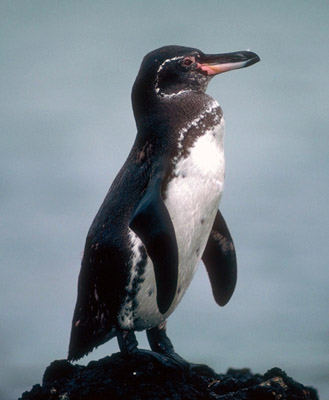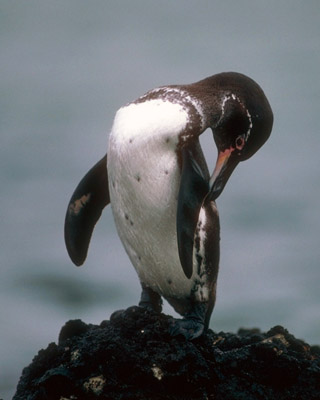The Galapagos Penguin is the only penguin found in the Northern Hemisphere (though only just) and the only penguin that breeds entirely within the tropics.
They are found more commonly in the Western Islands where the water is colder and will breed at any time of the year when there is adequate food supply. In practice, this means when the water temperature is below about 23C.
Galapagos Penguin - Sphensicus mendiculus
Profile - Animals of the Galapagos
Galapagos penguin facts Basics
Weight: 2.5kg (5.5 lbs), the second smallest species of penguin after the aptly named little penguin.
Length: about 50cm (1.65 feet) long.
Breeding Season: Any time during the year if food is plentiful, though usually between May and January. Warm water temperatures mean food is scarcer, El Nino raises the temperature and in these conditions breeding is delayed until they improve. The penguins pair for life which means they can begin to breed more quickly when food resources become more available again. Nests are made in holes or crevices in between rocks near to the shore line, like most penguin species, they lay two eggs of which only one usually survives. Chicks are looked after for about 2 months after hatching when they become independent, though some stay in small family groups for longer than this.
Estimated world population: - Smallest of any penguin species, exact size unknown, probably about 1200 individuals, though can vary significantly due to El Nino fluctuations. Previous estimates of the population have been 700 in 1983 and 10,000 in 1971.
Feeding: Small fish, particularly pelagic filter feeders such as sardines and anchovy, usually within about 1 km of the shore. In the right conditions mineral rich deep waters upwell around the Galapagos resulting in increased phytoplankton growth and therefore growth of herbivorous fish that the penguins feed on. When this upwelling doesn't occur, the food supply falls dramatically and has led to fatality rates of 70% in the penguin population.
Conservation status: Endangered. The historical trend is downwards with each El Nino event reducing the population size which has found it more difficult to recover afterwards.
Distribution: The western Galapagos Islands, Isabela, Fernandina, Floreana and Santiago, islands, and several offshore islets where the waters are cooler.
Predators: There are many predators as the penguins are small, in the sea they may be taken by sharks, fur seals and sea lions, on land there are native predators such as crabs, rice rats, snakes, hawks and owls and then introduced predators such as cats, dogs. They are also under threat from avian malaria spread by introduced mosquitoes.
What are Galapagos Penguins Like?
Adult birds are darker than youngsters which are more grey than black and lack the distinctive banding around the head and chest of the adults.
Unlike many penguin species, those from the Galapagos have the problem of overheating as one of their most common problems rather than having to keep warm as other cold environment penguins do. Their small size helps to increase the cooling rate, they swim in the sea to bring their temperature down and have other behavioural adaptations such as standing with extended flippers while warm blood flushes through them acting as radiators. They also tend to stand in a hunched posture on land in order to shade their feet from the sun.
Top banner credit - Gregory Slobirdr Smith - used under CC2 Attribution Share alike Generic license.


